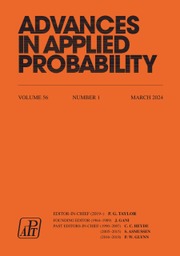Article contents
On asymptotic independence of the partial sums of positive and negative parts of independent random variables
Published online by Cambridge University Press: 01 July 2016
Extract
The aim of this study is an investigation of the joint limiting distribution of the sequence of partial sums of the positive parts and negative parts of a sequence of independent identically distributed random variables. In particular, let {X n } be a sequence of independent identically distributed random variables with common distribution function F, assume F is in the domain of attraction of a stable distribution with characteristic exponent α, 0 < α ≦ 2, and let {B n } be normalizing coefficients for F. Let us denote X n + = X n I [X n > 0] and X n − = − X n I [X n<0], so that X n = X n + - X n −. Let F + and F − denote the distribution functions of X 1 + and X 1 − respectively, and let S n (+) = X 1 + + · · · + X n +, S n (-) = X 1 − + · · · + X n −. The problem considered here is to find under what conditions there exist sequences of real numbers {a n } and {b n } such that the joint distribution of (B n -1S n (+) + a n , B n -1S n (-) + b n ) converges to that of two independent random variables (U, V). As might be expected, different results are obtained when α < 2 and when α = 2. When α < 2, there always exist such sequences so that the above is true, and in this case both U and V are stable with characteristic exponent a, or one has such a stable distribution and the other is constant. When α = 2, and if 0 < ∫ x 2 dF(x) < ∞, then there always exist such sequences such that the above convergence takes place; both U and V are normal (possibly one is a constant), and if neither is a constant, then U and V are not independent. If α = 2 and ∫ x 2 dF(x) = ∞, then at least one of F +, F − is in the domain of partial attraction of the normal distribution, and a modified statement on the independence of U and V holds. Various specialized results are obtained for α = 2.
Information
- Type
- Research Article
- Information
- Copyright
- Copyright © Applied Probability Trust 1971
References
- 5
- Cited by

